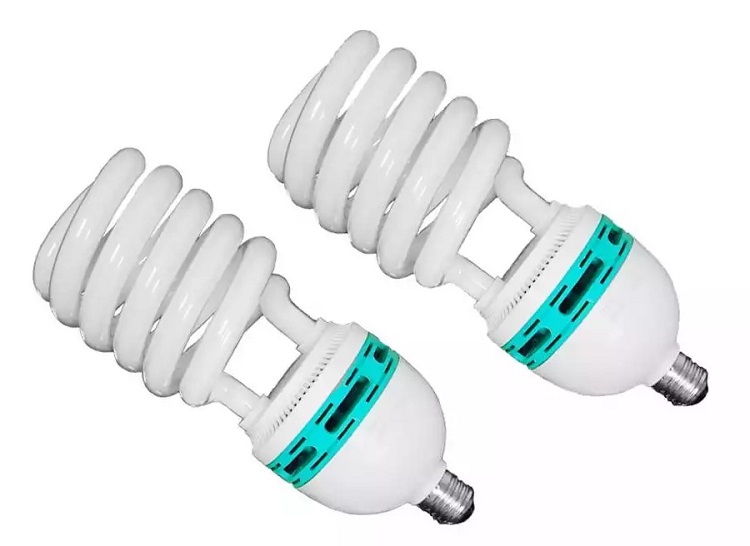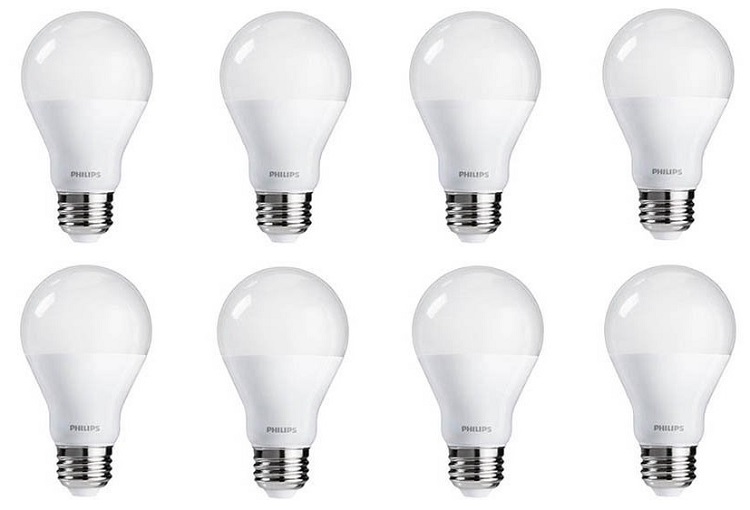Do LED Light Bulbs Really Save You Money?
If you swapped out your incandescent bulbs for compact fluorescent bulbs several years ago, you know how much expense was involved up front to save money in electrical bills down the road. Now green energy experts are telling you to make another costly swap, this time from fluorescent to LED bulbs. But do LED light bulbs save you money?
In other words, are you going to save enough money down the road by switching from compact fluorescent to LEDs to justify the up front cost? We’ll break down the various costs for light bulbs to help you figure out the best plan to use when moving to an all-LED household. (And if you’re still using all incandescent bulbs in your house — the green energy experts say, shame on you — we’ll break those costs down too.)
CFLs Vs. LEDs
Compact fluorescent lights (CFLs) and LEDs use different technologies. A CFL contains argon and mercury vapors inside a glass tube. Running an electrical current through these vapors creates visible light.
The technology in LED alternates currents with a positive and negative charge quickly to generate energy in the form of light.
An LED creates instantaneous light that also is dimmable, while a CFL must warm up for a few seconds before reaching its brightest level. Most people prefer the performance and light quality of an LED bulb to a CFL.
CFL Costs
Now it’s time for some math, starting with CFL bulbs. You can purchase CFL bulbs for about $2-$3 each for a standard bulb. And if you have the American household average of 40 light bulbs in your home running about three hours per day, you can expect to spend about $80 per year in energy costs if you’re using only CFLs. (Remember that a CFL bulb offers the equivalent brightness of a 60-watt incandescent bulb by only using about 13 watts.)
LED Costs
LED bulb prices still vary quite a bit. You may have paid $15 or $20 per bulb a couple of years ago, but you now can find LED bulbs for $3-$4 for a standard bulb … sometimes less. With 40 LED light bulbs in your home running about three hours per day, you’d spend about $55 per year energy costs. (An LED bulb with a 60-watt brightness equivalent uses about nine watts.)
Incandescent Costs
Although you can find incandescent bulbs for only $1-$2 apiece right now, we wouldn’t recommend buying any. If you have 40 incandescent light bulbs (60-watt variety) in your home running about three hours per day, you’d spend about $360 per year in energy costs. That’s a huge amount compared to CFL or LED technology.
The Scoreboard
So let’s break down the final numbers. For this chart, we’re assuming that you’ll operate each individual 60-watt equivalent brightness bulb in your home for roughly 1,000 hours per year and that you pay roughly $0.15 per kilowatt hour for power. (According to the U.S. Energy Information Association, residential Americans currently pay between 9.1 and 28.5 cents per kilowatt hour, depending on where they live; more on that later.)
Bulb Type...........INC.....CFL.....LED Cost per bulb.......$1.50 $2.50 $3.50 Lifespan in years...1.2 8 21 Wattage.............60 13 9 Energy Cost*........INC.....CFL.....LED Per 2 years.........$18 $3.90 $2.70 Per 5 years.........$45 $9.75 $6.75 Per 10 years........$90 $19.50 $13.50 Per 20 years........$180 $39 $27 Per 50 years........$450 $97.50 $67.50 *per bulb, approx. 3 hours lit per day Replacement Cost*...INC.....CFL.....LED Per 2 years.........$2.50 $0.62 $0.33 Per 5 years.........$6.25 $1.55 $0.83 Per 10 years........$13.50 $3.10 $1.66 Per 20 years........$27 $6.20 $3.33 Per 50 years........$67.50 $15.50 $8.33 *average cost in home with 40 bulbs
Total Cost*...........INC......CFL......LED 40 bulbs for 2 yrs...$820 $180.80 $121.20 40 bulbs for 5 yrs...$2,050 $452 $303 40 bulbs for 10 yrs..$4,100 $904 $606 40 bulbs for 20 yrs..$8,200 $1,808 $1,212 40 bulbs for 50 yrs..$20,500 $4,520 $3,030 *each bulb lit approx. 3 hours per day
Bottom Line: The Light Bulb Comes On
So what does it all mean for switching to an all LED bulb household?
- Swapping Out Incandescent. If you’re using incandescent bulbs, it’ll pay off immediately to switch to LED. You’ll outlay roughly $140 for 40 LED bulbs initially to replace your 40 incandescent bulbs. But you’ll save roughly $300 annually in energy costs. And one LED bulb will last about 20 times longer than an incandescent. That’s a no-brainer.
- Swapping Out CFL. If you’re using CFL, switching them out to LED all at once may not be quite as clearly beneficial. If you spend $140 for 40 LED bulbs as an initial outlay, the average American household will save roughly $25 in energy costs annually over 40 CFL bulbs. It’ll take nearly six years to receive your return on the initial $140 spend in terms of energy cost savings.
- Swapping Out a Mix. Now most people probably have a mix of incandescent and CFL bulbs (and maybe a few LEDs too) in their homes. We’d recommend immediately swapping out any incandescents for LEDs. Beyond that, it’s probably smartest to just swap out CFLs for LEDs when the CFLs burn out or when you want an improved look to your light. You aren’t going to have a huge energy cost savings by replacing CFLs that still have life in them for LEDs.
Because there’s no significant hurry to swap out CFLs for LEDs to save a bunch of money, we’d recommend waiting and watching the price of LED bulbs. When you see a significant sale on them, say for $2.75 per bulb or less, pick up several of them, as you’ll receive your return on your spend more quickly versus if you’re spending $3.50 or more per bulb. At $2.75 per LED bulb, the average American would receive a return on the upfront cost on 40 light bulbs in about four years instead of six, for example.
Advanced Math: It Matters Where You Live
We mentioned the EIA’s report on electricity costs survey earlier, which studies average energy costs for each state’s residents. If you live in a state where electricity costs are well above average per kilowatt, you’ll receive your payback on investment in LED bulbs sooner. The top 10 states for electricity costs are:
- Hawaii: 28.48 cents per kilowatt hour
- Alaska: 21.18 cents
- Connecticut: 19.66 cents
- Massachusetts: 19.15 cents
- New Hampshire: 19.11 cents
- Rhode Island: 18.17 cents
- California: 17.97 cents
- Vermont: 17.84 cents
- New York: 17.75 cents
- Maine: 16.24 cents
Back to our earlier example of swapping out 40 CFLs for 40 LED bulbs, if you’re in California and paying 17.97 cents per kilowatt hour, you’ll save roughly $30 in energy costs annually over using 40 CFL bulbs. That means you’ll be able to recoup your initial investment of $140 LED bulbs in almost five years, rather than the almost six years at the average cost of 15 cents per kilowatt hour (if you spend $3.50 per LED bulb).
On the flip side, those who live in states with inexpensive electricity will take much longer to recoup that initial investment in LED bulbs. The 10 lowest states for power costs, according to the EIA, are:
- Louisiana: 9.16 cents
- Oklahoma: 9.40 cents
- Washington: 9.51 cents
- Arkansas: 10.08 cents
- Idaho: 10.08 cents
- North Dakota: 10.30 cents
- Utah: 10.71 cents
- Nebraska: 10.73 cents
- Oregon: 10.75 cents
- Missouri: 10.79 cents
So if you live in Utah and choose to swap out 40 CFLs for 40 LED bulbs, you’ll save about $17 in energy costs annually over what you’d spend on CFLs. That means it’ll take nearly eight years to recoup your initial investment of $140 in LED bulbs at $3.50 per bulb, rather than the almost six years at the average cost of 15 cents per kilowatt hour.
Finally, those who use their bulbs more frequently than the average of three hours per day — such as when your son leaves all of the basement lights on all day after he leaves for school, no matter how many times you remind him not to — will recoup their initial investment in new LED bulbs more quickly.
What’s Next
Don’t assume LED bulbs represent the final rung on the climb in technological advancements for lighting at home. For example, one idea under development involves using laser diode technology. Eventually, it may produce hundreds of times as much light as an LED bulb for two-thirds of the energy cost. So what may happen is you’ll have a fiber optic cable carrying the light from the laser diode from socket to socket, allowing one laser diode to light several rooms.
While we wait for the next big thing in lighting, you can be certain that LED light bulbs will continue to undergo improvements in design and efficiency. Think about how LED bulbs have changed in just the past few years (and how much the price has dropped). More is certainly on the way, and we as consumers receive the benefit!
It’s amazing to think how far lighting has come in just the past couple of decades. Certainly, more technological advancements are on the way. But the prices of LED bulbs now are low enough that you can purchase some and enjoy the great benefits and lighting quality of LEDs now, rather than waiting on the sidelines for the next great thing to come.



















Pingback: 5 Energy Saving Holiday Gifts to Give Your Home – TexasElectricityRatings
Mary
August 26, 2018 at 8:43 pm
I find we have to replace the new led lights at about the same rate as the old bulb, I don’t think they are as bright as the old bulbs either. So in short I see no savings with the new led bulbs
Manitou
August 10, 2018 at 1:27 pm
When switching from incandescent bulbs there is also a substantial savings in removing heat load from your house that is not calculated into the savings. Old filament bulbs put out as much heat as they do light.
Pingback: How to Save Money on Your Energy Bills This Summer - Frugal Village
Pingback: How To Save Money Fast: 109 Best Ways To Save Money Today
Grintch
February 18, 2017 at 12:31 pm
There were an awful lot of crappy CFL bulbs made by those kind of people who hop on a trend to make a fast buck.
I bought only ones made by Opto-Lite and Feit and have had no problems.
Earlier on I had bought a few made by schlock brands but learned quickly.
I don’t plan to switch to LEDs as I find their light uncomfortably harsh.
Kyle Schurman
February 19, 2017 at 1:31 pm
Agreed there were some really poor CFLs built early on.
I really like the light quality from LEDs, but you’re not the first person I’ve heard from that doesn’t like it, so you’re definitely not alone in that regard!
Doug Dingle
February 10, 2017 at 1:53 pm
The issue I had with CFLs was not so much the cost – it’s that they tend to overheat and fail quickly. After installing about 20 of them, more than half failed in the first year, with the base nicely burned to a crispy brown. Also, they run hot overall, generate RF and IR interference, and are not so suitable for enclosed fixtures of any sort, no matter what it says on the packaging. And their color temperature is all over the place.
I’ve replaced the majority of lights in my three story house with LEDs, and with careful shopping was able to buy them relatively inexpensively.
I’m a HUGE stickler for color, and want them all at around 3200K to emulate incandescents, narrowing my selection possibilities considerably.
My favorites thus far are the recessed ones that Monoprice sells that replaced the regular floods in cans. They run really bright (the 75 watt equivalent ones put out more light than a 100 watt flood), are dimmable, install easily, and look and work great. I have no connection with Monoprice except as a satisfied customer.
Kyle Schurman
February 10, 2017 at 2:26 pm
Good information, I have noticed this problem with some CFLs burning out too, but usually it was with lesser known brand names.
Blah
February 9, 2017 at 2:43 pm
LED’s may not last longer, sometimes the power converter in the LED bulb breaks, the LED is still good but the bulb won’t light. I had one that only lasted 6 months. I write the dates on every bulb when I install them to make sure the manufacturers are honest. I have 6 bulbs and one has gone out, I bought these bulbs for 6$ a piece so I don’t know if the energy savings will pan out.
Kyle Schurman
February 10, 2017 at 2:27 pm
Interesting – I haven’t had this problem with any LED bulbs yet, so sorry to hear that you did. I’ll have to keep an eye out for it. I think you’ll receive your energy savings eventually with LED even at that price, it’ll just take a bit longer.
wes
February 9, 2017 at 12:33 pm
Plus led bulbs make significantly less heat which must be pulled out with the AC in hot climates.
Kyle Schurman
February 10, 2017 at 2:24 pm
Good point – with incandescent bulbs, the glass can reach 300 degrees Fahrenheit and more. And while the surface of an LED bulb is still hot, it’s usually only a little more than 100 degrees.
Devesh
February 9, 2017 at 4:53 am
Some states offer rebates on energy efficient bulbs every few months
I recently picked up 4 packs of Phillips 60w equivalent led bulbs for $2, making them cheaper than most other bulbs, at under 0.50c each, and 4 can lights for $5 each
The trick is to wait for these sales and slowly change the bulbs out, depending on which ones are used the most, as the prices keep falling over time.
Kyle Schurman
February 10, 2017 at 2:31 pm
Wow! That’s a great price, and good point on the energy efficiency rebates.